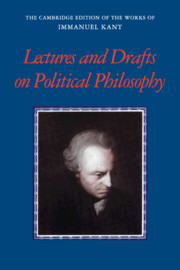Book contents
- Frontmatter
- Contents
- General Editors’ Preface
- Acknowledgments
- General Introduction
- Translators’ Remarks
- Reflections on the Philosophy of Right
- Natural Right Course Lecture Notes by Feyerabend
- Drafts for Published Works
- Drafts for Theory and Practice
- Drafts for Towards Perpetual Peace
- Drafts for the Metaphysics of Morals
- Drafts for Conflict of the Faculties
- Glossary
- Topical and Chronological Concordance
- Editorial Notes
- Index
General Introduction
Published online by Cambridge University Press: 10 December 2020
- Frontmatter
- Contents
- General Editors’ Preface
- Acknowledgments
- General Introduction
- Translators’ Remarks
- Reflections on the Philosophy of Right
- Natural Right Course Lecture Notes by Feyerabend
- Drafts for Published Works
- Drafts for Theory and Practice
- Drafts for Towards Perpetual Peace
- Drafts for the Metaphysics of Morals
- Drafts for Conflict of the Faculties
- Glossary
- Topical and Chronological Concordance
- Editorial Notes
- Index
Summary
Although Kant's interest in political philosophy started at the latest in the mid-1760s when his reading Rousseau “set him right” that his work should help to “establish the rights of humanity” (20:44), nearly all of his published work in the subject appeared only in the last decade of his life. In the remainder of the 1760s Kant sought his philosophical voice in a range of different approaches in various works, and during the entire 1770s he worked almost exclusively on what appeared in 1781 as the Critique of Pure Reason. In the 1780s while Kant focused on the critical system he published only one essay focused on political matters (“What is Enlightenment?”) and gave hints about his ideal political structure in two other works, a brief assessment of the ideal constitution as one centering on freedom in the first Critique (A316/B373) and a short overview of the ideal state and international order in “Idea for a universal history with a cosmopolitan aim” (8:22–28). Even after the French Revolution erupted in 1789 Kant withheld his views from the world of readers. Four years later Kant finally produced an essay giving details of his view on right (“On the common saying: That may be correct in theory but it is of no use in practice”), followed two years later by “Toward Perpetual Peace” largely about international relations and in twomore years, more than three decades after Rousseau set him right, the comprehensive Doctrine of Right in 1797.
Kant's publications are only the final step in the development of his views on right.The information we have of Kant's views on right prior to these published works comes through the material included in this volume. These unpublished materials offer three different ways to access Kant's thoughts. The Reflections – Kant's shorter sketches, outlines, and notes ranging in time from 1764 through the 1790s – reveal Kant's thoughts on particular topics as they develop. The course lecture notes on natural right from 1784 capture Kant's comprehensive views about a decade before he began to publish his major works on the subject.
- Type
- Chapter
- Information
- Kant: Lectures and Drafts on Political Philosophy , pp. xv - xxixPublisher: Cambridge University PressPrint publication year: 2016

